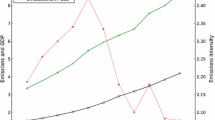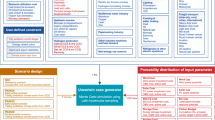Abstract
The paper analyzes how to comply with an emission constraint, which restricts the use of an established energy technique, given the two options to save energy and to invest in two alternative energy techniques. These techniques differ in their deterioration rates and the investment lags of the corresponding capital stocks. Thus, the paper takes a medium-term perspective on climate change mitigation, where the time horizon is too short for technological change to occur, but long enough for capital stocks to accumulate and deteriorate. It is shown that, in general, only one of the two alternative techniques prevails in the stationary state, although, both techniques might be utilized during the transition phase. Hence, while in a static economy only one technique is efficient, this is not necessarily true in a dynamic economy.
Similar content being viewed by others
References
Aaheim H (1999). Climate policy with multiple sources and sinks of greenhouse gases. Environ Resour Econ 14: 413–429
Aidt TS and Dutta J (2004). Transitional politics: emerging incentive-based instruments in environmental regulation. J Environ Econ Manage 47: 458–479
Asea PK and Zak PJ (1999). Time-to-build and cycles. J Econ Dyn Control 23: 1155–1175
Baumgärtner S, Schiller J (2001) Vielfalt und Nachhaltigkeit. Der Einfluss von Beständen und des Zeithorizonts auf zukünftige ökonomische Wahlmöglichkeiten. Z Angew. Umweltforschung, Special issue 13/2001:137–148
Bellman R and Cooke KL (1963). Differential-difference equations. Academic, New York
Bhaduri A (1968). An aspect of project selection: durability vs. construction-period. Econ J 78: 344–348
von Böhm-Bawerk E ([1889]1921) Kapital und Kapitalzins. Positive Theorie des Kapitals (Capital and Interest. The Positive Theory of Capital), 4th edn. First published in 1889. Macmillan, London
Böhringer C (2003). The Kyoto protocol: a review and perspectives. Oxford Rev Econ Policy 19: 451–466
Böhringer C and Vogt C (2003). Economic and environmental impacts of the Kyoto protocol. Can J Econ 36: 475–494
Boucekkine R, Licandro O, Puch LA and del Rio F (2005). Vintage capital and the dynamics of the AK model. J Econ Theory 120: 39–72
Buonanno P, Carraro C and Galeotti M (2003). Endogenous induced technical change and the costs of Kyoto. Resour Energy Econ 25: 11–34
Carraro C, Gerlagh R and van der Zwaan B (2003). Endogenous technical change in environmental maroeconomics. Resour Energy Econ 25: 1–10
Chichilnisky G (1996). An axiomatic approach to sustainable development. Soc Choice Welf 13: 231–257
Dellink R, Hofkes M, van Ierland E and Verbruggen H (2004). Dynamic modelling of pollution abatement in a CGE framework. Econ Model 21: 965–989
Diehl M, Leineweber DB, Schäfer AAS (2001) Muscod-II users’ manual. Preprint 2001-25, Interdisciplinary Center for Scientific Computing, University of Heidelberg, Heidelberg
El-Hodiri MA, Loehman E and Whinston A (1972). An optimal growth model with time lags. Econometrica 40: 1137–1146
Endres A and Finus M (1999). International environmental agreements: how the policy instrument affects equilibrium emissions. J Inst Theor Econ 155: 527–550
Endres A and Finus M (2002). Quotas may beat taxes in a global emission game. Int Tax Public Finance 9: 687–707
Faber M (1979). Introduction to modern Austrian capital theory. Springer, Heidelberg
Falk I and Mendelsohn R (1993). The economics of controlling stock pollutants: an efficient strategy for greenhouse gases. J Environ Econ Manage 25: 76–88
Feichtinger G, Hartl RF, Kort PM and Veliov MV (2006). Anticipation effects of technological progress on capital accumulation: A vintage capital approach. J Econ Theory 126: 143–164
Feichtinger G, Novak A and Wirl F (1994). Limit cycles in intertemporal adjustment models: theory and application. J Econ Dyn Control 18: 353–380
Fisher C, Parry I and Pizer W (2003). Instrument choice for environmental protection when technological innovation is endogenous. J Environ Econ Manage 45: 523–545
Gandolfo G (1996). Economic dynamics, Third, completely revised and enlarged edition. Springer, Berlin
Gerlagh R and Lise W (2005). Carbon taxes: a drop in the ocean, or a drop that erodes the stone? The effect of carbon taxes on technological change. Ecol Econ 54: 241–260
Gerlagh R and van der Zwaan B (2003). Gross world product and consumption in a global warming model with endogenous technological change. Resour Energy Econ 25: 35–57
Gersbach H and Glazer A (1999). Markets and regulatory hold-up problems. J Environ Econ Manage 37: 151–164
Gersbach H and Requate T (2004). Emission taxes and optimal refunding schemes. J Public Econ 88: 713–725
Gollier C and Treich N (2003). Decision-making under scientific uncertainty: the economics of the Precautionary Principle. J Risk Uncertain 27: 77–103
Goulder LH and Mathai K (2000). Optimal CO2 abatement in the presence of induced technological change. J Environ Econ Manage 39: 1–38
Goulder LH and Schneider SH (1999). Induced technological change and the attractiveness of CO2 abatement policies. Resour Energy Econ 21: 211–253
Hale J (1977). Theory of functional differential equations. Springer, New York
Hicks JR (1973). Capital and time: a neo-Austrian theory. Clarendon, Oxford
Hoel M and Karp L (2000). Taxes versus quotas for a stock pollutant. Resour Energy Econ 24: 367–384
IEA (2005) Projected costs of generating electricity—2005 update. OECD Nuclear Energy Agency (NEA) and International Energy Agency (IEA), Paris
Ioannides YM and Taub B (1992). On dynamics with time-to-build investment and non-separable leisure. J Econ Dyn Control 16: 225–241
Karp L (2005). Global warming and hyperbolic discounting. J Public Econ 89: 261–282
Kolstad CD (1996). Learning and stock effects in environmental regulation: the case of greenhouse gas emissions. J Environ Econ Manage 31: 1–18
Kydland FE and Prescott EC (1982). Time to build and aggregate fluctuations. Econometrica 50: 1345–1370
Laffont JJ and Tirole J (1996). Pollution permits and compliance strategies. J Public Econ 62: 85–125
Lange A (2003). Climate change and the irreversibility effect—combining expected utility and maximin. Environ Resour Econ 25: 417–434
Leineweber DB, Bauer I, Bock HG and Schlöder JP (2003). An efficient multiple shooting based reduced SQP strategy for large-scale dynamic process optimization—part I: theoretical aspects. Comput Chem Eng 27: 157–166
Li CZ and Löfgren KG (2000). Renewable resources and economic sustainability: a dynamic analysis with heterogenous time preferences. J Environ Econ Manage 40: 236–250
Lind RC (ed) (1982). Discounting for time and risk in energy policy. John Hopkins University Press, Baltimore
Liski M, Kort PM and Novak A (2001). Increasing returns and cycles in fishing. Resour Energy Econ 23: 241–258
Löschel A (2002). Technological change in economic models of environmental policy: a survey. Ecol Econ 43: 105–126
Moledina AA, Coggins JS, Polasky S and Costello C (2003). Dynamic environmental policy with strategic firms: prices versus quantities. J Environ Econ Manage 45: 356–376
Montero JP (2002). Permits, standards and technology innovation. J Environ Econ Manage 44: 23–44
Moslener U, Requate T (forthcoming) Optimal abatement in dynamic multi-pollutant problems when pollutants can be complements or substitutes. J Econ Dyn Control
Newell RG, Jaffe AB and Stavins RN (1999). The induced innovation hypothesis and energy-saving technological change. Q J Econ 114: 941–975
Newell RG and Pizer WA (2003). Regulating stock externalities under uncertainty. J Environ Econ Manage 45: 416–432
Nordhaus WD (2002) Modeling induced innovation in climate-change policy. In Grübler A, Nakicenovic N, Nordhaus WD (eds) Technological change and the environment. Resources for the Future, pp 182–209
Nuti DM (1970). Capitalism, socialism and steady growth. Econ J 80: 32–57
Pezzey JCV (2003). Emission taxes and tradeable permits: a comparison of views on long-run efficiency. Environ Resour Econ 26: 329–342
Phaneuf DJ and Requate T (2002). Incentives for investment in advanced pollution abatement technology in emission permit markets with banking. Environ Resour Econ 22: 369–390
Pizer WA (2002). Combining price and quality controls to mitigate global climate change. J Public Econ 85: 409–434
Portney PR, Weyant JP (eds) (1999). Discounting and intergenerational equity. Resources for the Future, Washington, DC
Requate T (forthcoming) Commitment and timing of environmental policy, adoption of new technology, and repurcussions on R&D. Environ Resour Econ
Requate T and Unold W (2003). Environmental policy incentives to adopt advanced abatement technology—will the true ranking please stand up. Eur Econ Rev 47: 125–146
Rubio SJ and Casino B (2005). Self-enforcing international environmental agreements with a stock pollutant. Span Econ Rev 7: 89–109
Ulph A and Ulph D (1997). Global warming, irreversibility and learning. Econ J 107: 636–649
United Nations Third Conference of the Parties of the Framework Convention on Climate Change (1997) Kyoto protocol to the United Nations framework convention on climate change. United Nations
Weitzman ML (1998). Why the far distant future should be discounted at its lowest possible rate. J Environ Econ Manage 36: 201–208
von Weizsäcker CC (1971). Steady state capital theory. Springer, Berlin
Winkler R (2003) Zeitverzögerte Dynamik von Kapital- und Schadstoffbeständen. Eine österreichische Perspective (Time-lagged Dynamics of Capital Stocks and Stocks of Pollutants. An Austrian Perspektive). Metropolis, Marburg
Winkler R (2004) Time-lagged accumulation of stock pollutants. Additively separable welfare functions reconsidered. Discussion-Paper No. 408, Alfred Weber-Institute of Economics, University of Heidelberg
Winkler R (2005). Structural change with joint production of consumption and environmental pollution: a neo-Austrian approach. Struct Change Econ Dyn 16: 111–135
Winkler R, Brand-Pollmann U, Moslener U, Schlöder J (2005) On the transition from instantaneous to time-lagged capital accumulation. The case of Leontief-type production functions. Discussion-Paper No. 05-30, Centre for European Economic Research (ZEW), Mannheim
Winkler R, Brandt-Pollmann U, Moslener U, Schlöder JP (2004) Time lags in capital accumulation. In: Ahr D, Fahrion R, Oswald M, Reinelt G (eds) Operations research proceedings. Springer, Heidelberg
Wirl F (1995). The cyclical exploitation of renewable resource stocks may be optimal. J Environ Econ Manage 29: 252–261
Wirl F (1999). Complex, dynamic environmental policies. Resour Energy Econ 21: 19–41
Wirl F (2002). Stability and limit cycles in competitive equilibria subject to adjustment costs and dynamic spillovers. J Econ Dyn Control 26: 375–398
Yang Z (2003). Reevaluation and renegotiation of climate change coalitions—a sequential closed-loop game approach. J Econ Dyn Control 27: 1563–1594
van der Zwaan BCC, Gerlagh R, Klaassen G and Schrattenholzer L (2002). Endogenous technological change in climate change modelling. Energy Econ 24: 1–19
Author information
Authors and Affiliations
Corresponding author
Rights and permissions
About this article
Cite this article
Winkler, R. Optimal compliance with emission constraints: dynamic characteristics and the choice of technique. Environ Resource Econ 39, 411–432 (2008). https://doi.org/10.1007/s10640-007-9133-4
Received:
Accepted:
Published:
Issue Date:
DOI: https://doi.org/10.1007/s10640-007-9133-4
Keywords
- Climate change mitigation
- Dynamic characteristics
- Emission targets
- Environmental policy
- Optimal structural change
- Replacement of energy techniques
- Static versus dynamic efficiency
- Time-lagged dynamic optimization




